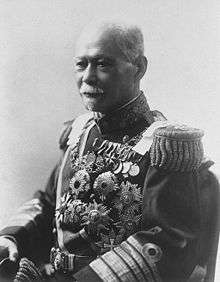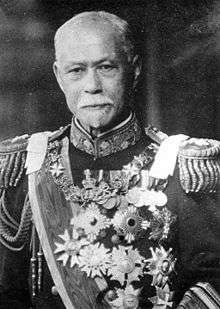Yamamoto Gonnohyōe
| Yamamoto "Gonnohyōe" Gonbee | |
|---|---|
| 山本 權兵衞 | |
 | |
| 16th and 22nd Prime Minister of Japan | |
|
In office 2 September 1923 – 7 January 1924 | |
| Monarch |
Taishō Hirohito (Regent) |
| Preceded by | Uchida Kōsai (Acting) |
| Succeeded by | Kiyoura Keigo |
|
In office 20 February 1913 – 16 April 1914 | |
| Monarch | Taishō |
| Preceded by | Katsura Tarō |
| Succeeded by | Ōkuma Shigenobu |
| Personal details | |
| Born |
26 November 1852 Kagoshima, Satsuma Domain, Japan |
| Died | 8 December 1933 (aged 81) |
| Resting place | Aoyama Cemetery, Tokyo |
| Political party | Independent |
| Awards |
Order of the Chrysanthemum (Collar and Grand Cordon) Order of the Golden Kite (1st class) Order of St Michael and St George (Honorary Knight Grand Cross) |
| Signature |
 |
| Military service | |
| Allegiance | Empire of Japan |
| Service/branch | Imperial Japanese Navy |
| Years of service | 1879–1928 |
| Rank | Admiral |
| Battles/wars |
Boshin War First Sino-Japanese War Russo-Japanese War |
Admiral Count Yamamoto Gonbee, GCMG (山本 權兵衞 Yamamoto Gonbee/Gonnohyōe, 26 November 1852 – 8 December 1933), also called Gonnohyōe,[1] was an admiral in the Imperial Japanese Navy and the 16th (20 February 1913 – 16 April 1914) and 22nd (2 September 1923 – 7 January 1924) Prime Minister of Japan.
Early life
Yamamoto was born in Kagoshima in Satsuma Province (now Kagoshima Prefecture) as the son of samurai who served the Shimazu clan. As a youth, he took part in the Anglo-Satsuma War. He later joined Satsuma's Eighth Rifle Troop; in the Boshin War that ended the Tokugawa shogunate, fighting at the Battle of Toba-Fushimi and other locations; he was also aboard one of the ships that pursued Enomoto Takeaki and the remnants of the Tokugawa fleet to Hokkaidō in 1869.
Naval career
After the success of the Meiji Restoration, Yamamoto attended preparatory schools in Tokyo, entering the 2nd class of the Imperial Japanese Naval Academy in 1870. After graduation in 1874, he went on a training cruise to Europe and South America aboard Imperial German Navy vessels from 1877–78, and as junior officer acquired much sea experience. He wrote a gunnery manual that became the standard for the Imperial Japanese Navy and served as executive officer of the cruiser Naniwa on its shakedown voyage from Elswick to Japan (1885–86). Afterwards, he accompanied Navy Minister Kabayama Sukenori on a trip to the United States and Europe (1887–88).
As commander of the cruiser Takao, undertook a confidential mission to meet Qing General Yuan Shikai in Hanseong (Seoul), Korea (1890). Afterwards, he assumed command of the Takachiho.
Working under his patron, Navy Minister Saigō Tsugumichi from 1893, Yamamoto became the real leader of the navy; initiating numerous reforms, attempting to end favoritism toward officers of his own Satsuma province, attempting to end officers from profiteering from military office, and attempting to attain roughly equal status with the army in the Supreme War Council. He also pushed for an aggressive strategy toward China in the First Sino-Japanese War (1894–95).

Yamamoto's subsequent rise through the ranks was rapid: rear admiral (1895); vice admiral and Navy Minister (1898). He was made baron (danshaku) under the kazoku peerage system in 1902; and he was promoted to the rank of admiral in 1904.
As Minister of the Navy during the Russo-Japanese War, Yamamoto showed strong leadership and was responsible for appointing Tōgō Heihachirō as commander-in-chief of the Combined Fleet. He gave voice to Tōgō's reports when he read his aloud his reports from the war to the assembled Diet.[2]
Yamamoto was elevated to count (hakushaku) in 1907.
Count Yamamoto served as Prime Minister in 1913–14.
As Prime Minister

During Yamamoto's first term as the prime minister, he abolished the rule that both the Navy Minister and Army Minister had to be active duty officers, and he had a reputation for being a liberal and a supporter of public claims for democracy and constitutional government. However, his administration was plagued by charges of corruption and he was forced to resign with his entire cabinet to take responsibility for the Siemens-Vickers Naval Armaments scandal, even though it was never proved that he was personally involved.
Yamamoto was transferred to naval reserve in 1914.
Yamamoto was recalled to government as Prime Minister again in the emergency crisis "earthquake cabinet" (1923–24) following the Great Kantō earthquake. He showed leadership in the restoration of Tokyo which had been heavily damaged by the earthquake. He also attempted to reform the electoral system to permit universal male suffrage. However, he and his cabinet resigned again in January 1924, this time over the attempt by Namba Daisuke to assassinate Prince Regent Hirohito on 27 December 1923 (the Toranomon Incident).
Subsequently, Yamamoto withdrew from political life completely. He died in 1933 and his grave is at the Aoyama Cemetery in Tokyo.[3]
Honors
From the corresponding article in the Japanese Wikipedia
- Baron (1902)
- Count (1907)
- Order of the Golden Kite, 1st class (1 April 1906)
- Grand Cordon of the Supreme Order of the Chrysanthemum (10 November 1928)
- Order of St Michael and St George, Honorary Knight Grand Cross, 1907.[4]
- Collar of the Order of the Chrysanthemum (9 December 1933)
Notes
- ↑ The name Gonnohyōe was originally invented by a Shinto priest during a prayers at a ship launching ceremony which Yamamoto attended; he liked the profound sound of the name so much that he adopted it thereafter.
- ↑ "Article 6 – no title," New York Times. 30 March 1904.
- ↑ Sakanoue-no-kumo Photo archives (Japanese)
- ↑ London Gazette: on the occasion of Prince Fushimi Sadanaru's visit to England
References
- Dupuy, Trevor N. (1992). Encyclopedia of Military Biography. I B Tauris & Co Ltd. ISBN 1-85043-569-3.
- Schencking, J. Charles (2005). Making Waves: Politics, Propaganda, And The Emergence Of The Imperial Japanese Navy, 1868–1922. Stanford University Press. ISBN 0-8047-4977-9.
- Sims, Richard (2005). Japanese Political History Since the Meiji Renovation 1868–2000. Palgrave Macmillan. ISBN 0-312-23915-7.
| Wikimedia Commons has media related to Yamamoto Gonnohyōe. |
External links
- Nishida, Hiroshi. "Materials of IJN: Yamamoto, Gonbee". Imperial Japanese Navy. Retrieved 2007-08-03.
- London Gazette Issue 28019
| Political offices | ||
|---|---|---|
| Preceded by Saigō Tsugumichi |
Minister of the Navy November 1898 – January 1906 |
Succeeded by Saitō Makoto |
| Preceded by Katsura Tarō |
Prime Minister of Japan February 1913 – April 1914 |
Succeeded by Ōkuma Shigenobu |
| Preceded by Uchida Kōsai |
Minister of Foreign Affairs September 1923 – September 1923 |
Succeeded by Ijuin Hikokichi |
| Preceded by Uchida Kōsai Acting |
Prime Minister of Japan September 1923 – January 1924 |
Succeeded by Kiyoura Keigo |
